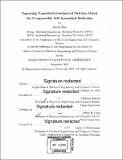| dc.contributor.advisor | Vladimir Bulović and Jeffrey H. Lang. | en_US |
| dc.contributor.author | Han, Jinchi | en_US |
| dc.contributor.other | Massachusetts Institute of Technology. Department of Electrical Engineering and Computer Science. | en_US |
| dc.date.accessioned | 2019-02-14T15:48:29Z | |
| dc.date.available | 2019-02-14T15:48:29Z | |
| dc.date.copyright | 2018 | en_US |
| dc.date.issued | 2018 | en_US |
| dc.identifier.uri | http://hdl.handle.net/1721.1/120403 | |
| dc.description | Thesis: S.M., Massachusetts Institute of Technology, Department of Electrical Engineering and Computer Science, 2018. | en_US |
| dc.description | Cataloged from PDF version of thesis. | en_US |
| dc.description | Includes bibliographical references (pages 115-122). | en_US |
| dc.description.abstract | Nanoelectromechanical (NEM) switches are investigated as a promising candidate for energy-efficient logic devices. They promise quasi-zero static leakage, large on-off current ratio, small subthreshold slope and high robustness in harsh environments. However, strong van der Waals interaction at the nanoscale usually results in high hysteresis and the risk of stiction failure, thereby bringing about an inevitably high actuation voltage and unfavorable dynamic power consumption in practical device designs. The low switching speed, poor reliability and absence of scalable manufacturing technique also set barriers to the maturation of NEM switches to complement or substitute semiconductor transistors for applications with energy constraints. To accelerate the development of NEM switches for digital logic, this thesis presents a novel squeezable NEM switch, termed a "squitch", based on direct tunneling through a metal-molecule-metal junction, whose tunneling gap can be electromechanically modulated by compressing the molecular layer. A sub-5 nm change in the tunneling gap in the absence of direct contact between electrodes leads to at least several orders of magnitude current modulation, enabling a squitch to exhibit a low actuation voltage near 2 V, a low hysteresis and a high switching speed, which support the prospects of squitches as ultra-low power beyond-CMOS devices. A scalable and versatile dielectrophoretic trapping technique for fabrication of devices involving nanoparticles in design has also been developed in this thesis as a critical fabrication step. | en_US |
| dc.description.statementofresponsibility | by Jinchi Han. | en_US |
| dc.format.extent | 122 pages | en_US |
| dc.language.iso | eng | en_US |
| dc.publisher | Massachusetts Institute of Technology | en_US |
| dc.rights | MIT theses are protected by copyright. They may be viewed, downloaded, or printed from this source but further reproduction or distribution in any format is prohibited without written permission. | en_US |
| dc.rights.uri | http://dspace.mit.edu/handle/1721.1/7582 | en_US |
| dc.subject | Electrical Engineering and Computer Science. | en_US |
| dc.title | Tunneling nanoelectromechanical switches based on compressible self-assembled molecules | en_US |
| dc.title.alternative | Tunneling NEM switches based on compressible self-assembled molecules | en_US |
| dc.type | Thesis | en_US |
| dc.description.degree | S.M. | en_US |
| dc.contributor.department | Massachusetts Institute of Technology. Department of Electrical Engineering and Computer Science | |
| dc.identifier.oclc | 1083765897 | en_US |
